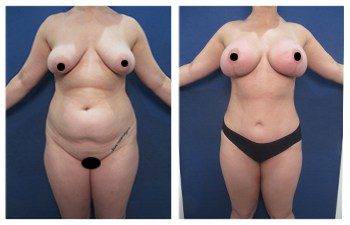
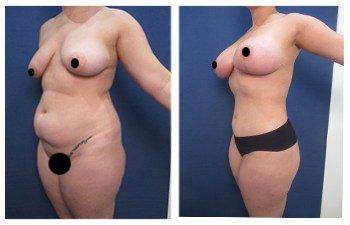
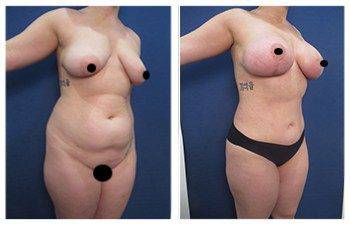
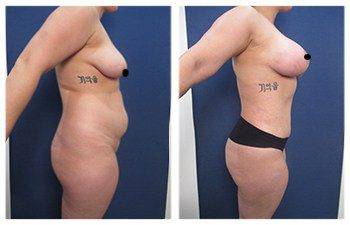
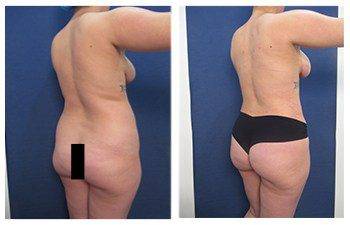
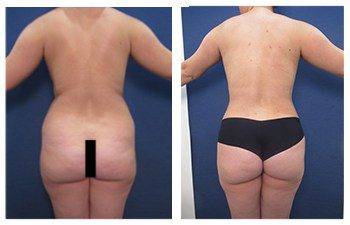
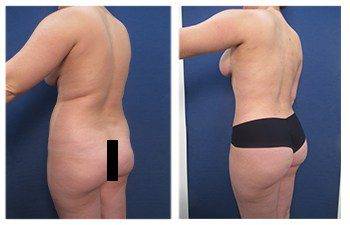
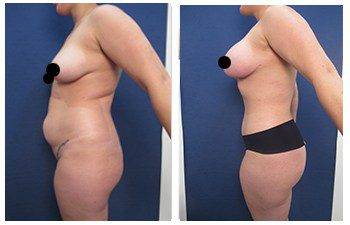
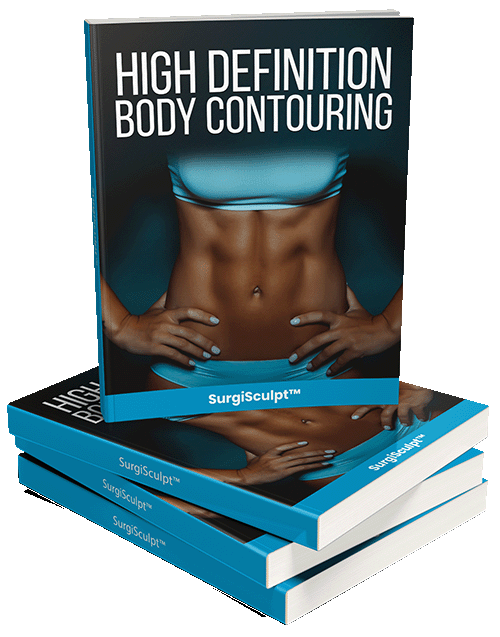
Download SurgiSculpt’s free Liposuction eBook
Introduction: Tips for fat recovery after VASER liposuction
Tips for fast recovery after VASER liposuction are unique for VASER liposuction. This is because of VASER liposuction’s unique use of ultrasound energy to cavitate or melt the fat into a liquid state prior to extraction.
Cavitation means that the fat throughout your body will be in a liquid state for approximately 8 to 10 days following surgery. As you might assume, anything liquid is very mobile and will tend to accumulate in the most dependent locations. In fact, a few days following surgery, you will find yourself standing up as you increase your activity, get out of bed, and walk around the house.
As you become more upright, all of the liquid fat tends to fill along the most dependent areas; these include the pubic region in the front and over the upper buttock in the back. This is why drains are routinely used since they help remove the liquid fat. In addition, compression garments with customized foam in-lays are used to avoid localized pooling of fluid and to encourage liquid fat to drain through drainage tubes.
Tips for fast recovery after VASER liposuction take into consideration all attempts to hasten the completion of drainage. Drainage of the liquefied fat is through both drainage tubes but also through blood vessels.
When undergoing surgery, the soft tissues are irritated thus preventing pro-inflammatory cells from entering the soft tissues and making the blood vessels leaky. This process is referred to as third spacing which describes the body dumping fluid into the soft tissues.
Tips for fast recovery after VASER liposuction must take into consideration limiting the third spacing. The most critical component to limiting third spacing is to ensure high protein levels in your bloodstream. This will ensure that fluid remains in the blood vessels and does not leak out. To increase blood protein levels, clients are encouraged to intake 150 grams of protein a day.
Dietary means of increasing your protein levels include eating a lot of chicken and meat. Your blood protein level can be measured with a lab test to check your albumin levels. If your albumin levels are found to be low and you would like to make an attempt to improve your protein levels, prealbumin can be checked that will indicate a change in your protein levels within the immediate two weeks.
In addition, patients should attempt to avoid all blood thinning products that can encourage the oozing of blood products from their vessels. At our office, we provide you a list of a thousand food products, supplements, and medications that can thin your blood. It is recommended that you strictly avoid products on your list for at least one month prior to and two weeks following your VASER surgery for fast recovery after VASER liposuction.
Finally, patients should avoid any products that are considered vasodilatory in nature. The most concerning one involves marijuana which has become legalized in many states throughout the country. Although this naturally occurring herb can be considered a pain suppressant, it should be avoided in the operative period as it results in the dilation of blood vessels.
Dilitation of vessels can have a detrimental effect on your recovery resulting in hemorrhage and/or development of delayed blood accumulation called a hematoma. In summary, tips for recovery after VASER liposuction include optimizing your health by increasing your protein intake, avoiding blood thinners and/or vasodilating agents, and being compliant with wearing your compression garments at all times in the early postoperative period.
Remember that the sooner you finish draining, the quicker the drains are removed. This reality seems to the be strongest driving force to being compliant with VASER liposuction recommendations. Believe it or not, the removal of drains remains the strongest driving force for most patients who find the management of drains a hassle!
Remember that liquid fat does convert back to its solid state within 8 to 10 days. This is why regular lymphatic messages during the first week after VASER liposuction are critical to optimizing overall results and for fast recovery after VASER liposuction.
Not only will lymphatic massage assist in ridding your body of accumulation of liquid fat, but it also provides us the opportunity to fine-tune your contour while the fat is liquid and malleable. At our center, we recommend lymphatic messages every day following your VASER surgery. Tips for a fast recovery for VASER liposuction are several and all measures should be followed to ensure optimum body contouring results. Now let’s get into more detail.
4 Tips to Recognize About Your Vaser Liposuction Recovery – Cosmos Clini
Recovering from Vaser Liposuction is a crucial and often overlooked aspect of the cosmetic procedure. Understanding what to expect and how to best take care of yourself during this time is essential for a smooth and successful recovery. In this article, we will provide you with four important tips to recognize about your Vaser Liposuction recovery, focusing on key aspects such as managing discomfort, monitoring your progress, promoting healing, and following post-operative instructions. These tips will help you navigate the recovery process with confidence and ensure that you achieve optimal results from your Vaser Liposuction procedure. At SurgiSculpt, we prioritize patient care and want to ensure that you have all the information you need to make your recovery as comfortable and successful as possible.
Manage leakage of fluid
After undergoing Vaser Liposuction, it is common to experience leakage of fluid from the incision sites. To help manage this, drains may be placed to assist in the removal of any excess fluid. These drains are typically left in place for 4-5 days to aid in the healing process and reduce the risk of complications.
During the recovery period, it is important to carefully monitor the drains and the amount of fluid being collected. It is normal for some leakage to occur, but if you notice a sudden increase in the amount of fluid or any signs of infection, it is important to contact your healthcare provider immediately.
At your follow-up consultations, the drains will be assessed, and if everything is healing properly, they will be removed. It is important to follow your healthcare provider’s instructions regarding drain care to minimize the risk of infection and ensure a smooth recovery.
Overall, the use of drains after Vaser Liposuction plays a crucial role in managing the leakage of fluid from the incisions, promoting proper healing, and reducing the risk of complications during the recovery period.
Wearing a compression garment & binder
After Vaser Liposuction, it is important to wear a compression garment full-time for the first three weeks to reduce swelling, aid in proper healing, and improve the contour of the treated area. This garment should be snug but not too tight, providing even pressure and support to the treated areas. It should be worn continuously, only being removed for showering and washing the garment.
For the following three weeks, the compression garment should be worn part-time, typically for 12-14 hours a day, to continue supporting the healing process and maintaining the desired shape. During this time, it is important to gradually increase your activity level and wear the garment as needed for comfort.
For tummy liposuction, a binder may be recommended in addition to the compression garment. The binder should be worn around the abdomen to provide extra support and compression specifically to the treated area. This will help to reduce swelling and promote a smoother outcome.
It is important to follow these instructions diligently to achieve the best results and ensure proper healing after Vaser Liposuction.
Lymphatic drainage massage
Lymphatic drainage massage plays a crucial role in the recovery process after Vaser or traditional liposuction procedures. This type of massage helps reduce swelling, bruising, and discomfort by stimulating the lymphatic system to remove excess fluid and toxins from the body. The gentle, rhythmic movements of the massage encourage the flow of lymph fluid, which in turn helps to decrease recovery time and promote healing.
During the first 10 days of recovery, it is recommended to have lymphatic drainage massage sessions every other day for 45-60 minutes. This frequent and regular schedule is crucial in optimizing the benefits of the massage in reducing swelling and discomfort. As the body heals, the frequency and duration of the sessions can be adjusted accordingly.
By incorporating lymphatic drainage massage into the recovery process, patients can expect to experience a faster healing time and reduced discomfort. It also helps to improve the overall results of the liposuction procedure by promoting a smoother and more even skin texture. Overall, lymphatic drainage massage is an essential component in the post-operative care plan for Vaser or traditional liposuction procedures.
Pain management
After Vaser Liposuction is crucial to ensure a smooth and effective recovery process. It is essential to take the prescribed medications on schedule, even if you are not experiencing severe pain. This will help to manage any discomfort and prevent the pain from becoming unbearable.
It is important to understand that controlling pain is crucial for effective recovery. If the prescribed medications do not seem to provide relief or if you are in significant pain, it is important to contact your surgeon immediately. They can assess the situation and make any necessary adjustments to your medication or treatment plan.
By managing post-Vaser Liposuction pain effectively, you can avoid extreme amounts of discomfort and support your body’s healing process. Remember to stay in communication with your surgeon and follow their guidance closely for the best outcome.
Prioritizing pain management is essential for a successful recovery process after Vaser Liposuction. With proper care and attention to pain management, you can support your body’s healing process and minimize any post-operative discomfort.
Recovery after Vaser Liposuction
After Vaser Liposuction, the average recovery period is typically 1-2 weeks, during which time patients should rest and avoid strenuous activities. Light walking is encouraged to promote circulation and reduce the risk of blood clots. Patients can typically resume desk jobs within a few days, while those with more physically demanding jobs may need to wait 1-2 weeks before returning to work. Post-surgery care includes wearing compression garments as directed, managing any discomfort with prescribed pain medication, and following a healthy diet to promote healing.
Follow-up appointments are crucial for monitoring the recovery process and addressing any concerns. These appointments may include a review of post-operative care, monitoring the healing progress, and discussing any potential follow-up treatments. It’s important to follow all post-surgery care instructions provided by the surgeon to ensure a smooth recovery and optimal results. As always, patients should consult with their surgeon for personalized recovery instructions based on their specific treatment and medical history.
Liposuction Recovery Hints and Tips
Liposuction Recovery Hints and Tips: Recovering from liposuction can be a challenging process, but with the right care and attention, you can ensure a smooth and successful recovery. From managing pain and swelling to getting back to regular activities, these hints and tips will help you navigate the recovery process and get back to feeling your best as quickly as possible.
Be prepared to bloat
and experience constipation after your procedure, especially if you are taking medication that may exacerbate these symptoms. To address this discomfort, it is important to incorporate high-fiber foods into your diet. Foods such as fresh fruits, wholemeal bread, and whole-grain cereals are all great sources of fiber that can help alleviate bloating and constipation.
Make a conscious effort to include these high-fiber foods in your meals to promote healthy digestion and regular bowel movements. Aim to consume at least 25-30 grams of fiber each day, spread out over your meals and snacks. Be sure to drink plenty of water as well, as fiber works best when it absorbs water in the digestive tract.
Remember that it is important to be proactive in managing these symptoms, especially given the effects of the medication you are taking. By making small changes to your diet and staying hydrated, you can help alleviate bloating and constipation, and improve your overall comfort.
Wear your recovery garment
It is crucial to wear your recovery garment after vaser surgery to aid in your quick recovery. The garment provides essential support to the treated areas, improves circulation, and helps reduce any swelling. Following your doctor or nurse’s advice on how long to wear the garment is important as this may vary depending on the areas treated and the type of laser surgery you have undergone.
When removing the garment, it is advisable to have someone on hand to assist you, especially if you feel light-headed or faint. The compression provided by the recovery garment plays a vital role in the healing process, so it is essential to wear it as directed. By wearing the garment as instructed, you can enhance your recovery and achieve optimal results from your VASER surgery.
In summary, the recovery garment is a crucial part of the post-operative care for VASER surgery. It provides support, improves circulation, and reduces swelling, all of which contribute to a faster and more comfortable recovery. Be sure to follow your healthcare provider’s guidance on wearing the garment to support your body’s healing process effectively.
Buy a mattress protector
Mattress protectors come in a variety of options to help protect your mattress during the initial post-procedure leaking period. A waterproof mattress protector is an essential option to consider, as it will ensure that any leaks do not damage the mattress. Waterproof mattress protectors are designed to prevent any liquid from seeping into the mattress, keeping it clean and dry. Additionally, breathable mattress protectors are also available, which are designed to allow air to flow through the protector while still providing a waterproof barrier.
During the post-procedure period, it is important to keep the mattress protected from any potential leaks or spills. By purchasing a mattress protector, you can ensure that your mattress remains in good condition and is not damaged by any liquid. Look for options that are specifically designed for waterproof and breathable protection to provide the best defense for your mattress. Investing in a quality mattress protector will give you the peace of mind that your mattress is safeguarded during this vulnerable time.
Liposuction Recovery Timeline
After undergoing liposuction surgery, it’s important to have a clear understanding of what to expect during the recovery process. From the immediate post-operative period to the final results, this timeline will guide you through the typical stages of liposuction recovery. Understanding the expected timeline can help you plan and prepare for the physical and emotional aspects of healing.
Eat Well
After undergoing liposuction, it’s essential to follow a specific post-recovery diet to support the healing process. Increasing protein intake is crucial for wound healing, so incorporate lean proteins such as chicken, turkey, fish, eggs, and legumes into your meals. Avoiding excessive sugar is important as it can suppress the immune system, so opt for natural sweeteners like honey or fruits. Consuming small, frequent meals throughout the day can help prevent nausea and bloating.
Fruits and vegetables play a vital role in promoting healing post-liposuction. Incorporate watermelon, strawberries, grapefruits, celery, and zucchini into your diet, as they are rich in vitamins and minerals that can aid in the recovery process. These foods also provide essential nutrients and antioxidants that can support your body’s healing mechanisms.
In summary, the recommended post-liposuction recovery diet emphasizes increased protein intake for wound healing, reduced sugar intake to support the immune system, and consuming small, frequent meals to avoid discomfort. Including fruits and vegetables such as watermelon, strawberries, grapefruits, celery, and zucchini can further aid in the healing process. By following these dietary recommendations, you can support your body’s recovery and promote optimal healing.
Keep Moving
Following liposuction, it is crucial to prioritize rest in the first 24 hours to allow your body to heal. Once your surgeon gives the green light, incorporating light exercise and movement into your recovery process can help improve circulation, reduce swelling, and promote healing. Specifically, gentle activities such as short walks, stretching, and light yoga can be beneficial in promoting blood flow and preventing stiffness.
However, it is important to avoid any intensive exercise or heavy lifting for the first few weeks to prevent complications and allow your body to fully recuperate. Your surgeon can provide personalized guidance on when it is safe to gradually reintroduce more strenuous activities.
Incorporating light exercise must be done gradually, listening to your body and avoiding any pain or discomfort. This will help you ease back into your regular exercise routine and prevent any setbacks in your recovery. Remember, following your surgeon’s advice and individual recovery timeline is crucial for a successful and smooth recovery after liposuction.
Stay Hydrated
During recovery from liposuction, it is crucial to stay properly hydrated. The recommended beverages for maintaining hydration include water, low-sugar and low-sodium juices, non-caffeinated tea, and coffee. These beverages will help to replenish fluids lost during the surgical procedure and promote healing.
As for reintroducing beverages with higher levels of sugar, sodium, and caffeine, it is important to consult with your healthcare provider. Generally, it is best to wait until the initial phase of recovery has passed before gradually reintroducing these beverages into your diet. This will help to prevent any potential complications or setbacks in the healing process.
Drinking plenty of fluids is essential for flushing the anesthesia from the system. Anesthesia can cause dehydration, so adequate fluid intake can help to eliminate it from the body more efficiently. Proper hydration also aids in preventing blood clots and promoting overall well-being during the recovery period.
In summary, following guidelines for hydration and careful reintroduction of certain beverages can significantly contribute to a smooth recovery after liposuction. Consult with your healthcare provider for personalized recommendations and always prioritize staying adequately hydrated.
Follow recovery instructions properly
After your plastic surgery, it is important to strictly follow the recovery instructions provided by your plastic surgeon. This includes properly caring for your bandages by keeping them dry and clean, and changing them as instructed. Plan ahead for your meals by stocking up on easy-to-prepare foods and having someone available to assist you with meal preparation if needed. It is also important to have a support network in place, whether it be family or friends, to help with daily tasks and provide emotional support during your recovery.
Before your surgery, ensure that you have appropriate clothing and toiletries for the recovery period. This may include loose and comfortable clothing that is easy to put on and take off without causing discomfort to your wounds. Additionally, be prepared to follow instructions for cleaning yourself without getting your wounds or garments wet, such as using gentle sponge baths or avoiding showering until cleared by your surgeon.
By following these recovery instructions, you can help ensure a smooth and successful healing process after your plastic surgery.
Conclusion: Recovery Tips after VASER Liposuction
In conclusion, following recovery tips after VASER Liposuction is crucial for achieving optimal results. The use of fluid-absorbing pads and pressure garments helps reduce swelling and promotes proper healing. Post-op lymphatic massage aids in the drainage of fluid, while post-op wound care is essential for preventing infection and promoting healing. It is important to avoid exercise, alcohol, and smoking as they can hinder the recovery process.
Patience is key in allowing for the retraction of swelling and bruising, and in achieving the desired outcome. It is essential to follow the recovery instructions provided by a plastic surgeon, as they are tailored to each individual and their specific procedure. By following these recovery tips, patients can ensure a smooth and successful recovery, ultimately leading to the best possible results from VASER Liposuction.
